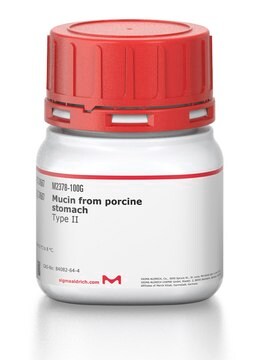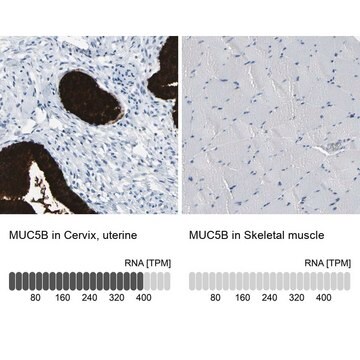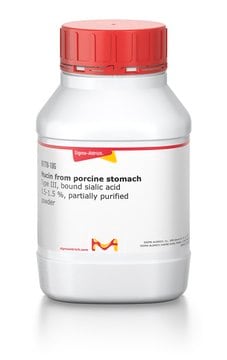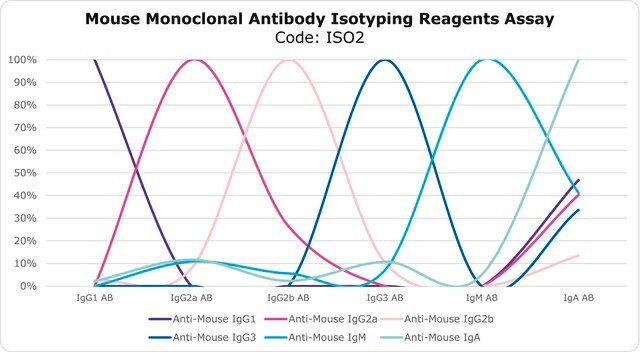추천 제품
생물학적 소스
mouse
Quality Level
결합
unconjugated
항체 형태
ascites fluid
항체 생산 유형
primary antibodies
클론
45M1, monoclonal
포함
15 mM sodium azide
종 반응성
chicken, monkey, rat, rabbit, pig, hedgehog, mouse, human, feline
기술
immunocytochemistry: suitable
immunohistochemistry (formalin-fixed, paraffin-embedded sections): 1:200 using sections of human stomach
western blot: suitable using non-reducing conditions
동형
IgG1
UniProt 수납 번호
배송 상태
dry ice
저장 온도
−20°C
타겟 번역 후 변형
unmodified
유전자 정보
human ... MUC5AC(4586)
mouse ... Muc5ac(17833)
rat ... Muc5ac(682837)
일반 설명
Monoclonal Anti-Human Gastric Mucin (mouse IgG1 isotype) is derived from the 445M1 hybridoma produced by the fusion of mouse myeloma cells and splenocytes from BALB/c mice immunized with mucin isolated from human ovarian cyst fluid. Mucin is a high M.W. (1,000 kDa) glycoprotein, expressed by mucus cells of the gastric epithelium and by goblet cells of the fetal, precancerous and cancerous colon, but not by those of the normal colon. It also appears in other epithelial tissues, which are embryologically derived from the foregut (epigastric and bronchial epithelium) and in Müller ducts (mucus cells of the endocervix and urethral epithelium near the prostatic utriculus).
Mucin has a netlike, branched structure and is a secreted protein. It belongs to the category of gel-forming mucins. The gene encoding this protein is upregulated by interleukin-1β (IL-1β) and is localized on chromosome 11p15.5.
특이성
The antibody recognizes the mucin epitope g located in the peptide core of gastric mucin (>1,000 kDa). This epitope is completely destroyed by thiol reduction (using mercaptoethanol) and partially lost following trypsin proteolysis, but is stable upon periodate oxidation. The antibody stains the surface gastric epithelium of normal human gastrointestinal tract and reacts with fetal, pre-cancerous and cancerous colonic mucosa, but not with normal colon.
면역원
mucin from human ovarian cyst fluid.
애플리케이션
Applications in which this antibody has been used successfully, and the associated peer-reviewed papers, are given below.
Immunofluorescence (1 paper)
Immunofluorescence (1 paper)
Monoclonal Anti-Human Gastric Mucin may be used for the localization of gastric mucin using various immunochemical assays such as immunoblot, immunofluorescence, immunohistochemistry, immunostaining and immunoradiofixation.
생화학적/생리학적 작용
Mucin is composed of a peptide core containing heavily glycosylated regions and nonglycosylated regions. The heavily glycosylated components of mucin consist of a mosaic of epitopes, some of which are associated with saccharide moieties and are related to blood-group antigens, and others which are M1 antigens associated with the peptidic core. M1 antigens are common to human ovarian mucinous cyst fluids and to gastric mucosa. M1 is distributed in various human tumors such as the colon, stomach, pancreas, ovary, Barrets′ esophagus, endocervix, and endometrium carcinomas.
면책조항
Unless otherwise stated in our catalog or other company documentation accompanying the product(s), our products are intended for research use only and are not to be used for any other purpose, which includes but is not limited to, unauthorized commercial uses, in vitro diagnostic uses, ex vivo or in vivo therapeutic uses or any type of consumption or application to humans or animals.
적합한 제품을 찾을 수 없으신가요?
당사의 제품 선택기 도구.을(를) 시도해 보세요.
WGK
nwg
Flash Point (°F)
Not applicable
Flash Point (°C)
Not applicable
가장 최신 버전 중 하나를 선택하세요:
J Bara et al.
International journal of cancer, 47(2), 304-310 (1991-01-21)
The gastric mucin M1 antigens, markers associated with colonic carcinogenesis, have been characterized by new antimucin monoclonal antibodies (MAbs). These MAbs, obtained against mucins isolated from a human ovarian mucinous cyst (MAbs 19M1, 21M1 and 45M1) and from a pancreatic
MUC5AC upstream complex repetitive region length polymorphisms are associated with susceptibility and clinical stage of gastric cancer.
Wang C
PLoS ONE, 9(6), e98327-e98327 (2014)
J Bara et al.
Journal of immunological methods, 149(1), 105-113 (1992-04-27)
Periodate pretreatment of paraffin sections of ethanol-fixed gastrointestinal mucosae was used to characterize the carbohydrate or peptidic nature of mucin epitopes by immunoperoxidase. Immunoreactivity of monoclonal antibodies (MAbs) against histo-blood group related carbohydrate epitopes such as A, Lea, Lec, Sialosyl
Emma C Skoog et al.
PloS one, 7(5), e36378-e36378 (2012-05-09)
Helicobacter pylori colonizes the mucus niche of the gastric mucosa and is a risk factor for gastritis, ulcers and cancer. The main components of the mucus layer are heavily glycosylated mucins, to which H. pylori can adhere. Mucin glycosylation differs
Optimized Protocol for Regeneration of the Conjunctival Epithelium Using the Cell Suspension Technique.
Bertolin M, et al.
Cornea, 38(4), 469-479 (2019)
자사의 과학자팀은 생명 과학, 재료 과학, 화학 합성, 크로마토그래피, 분석 및 기타 많은 영역을 포함한 모든 과학 분야에 경험이 있습니다..
고객지원팀으로 연락바랍니다.







